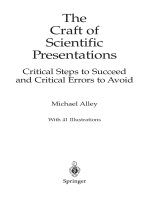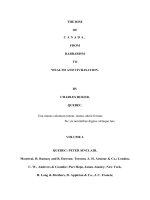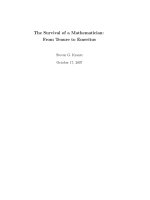Deciphering the secrets of silks from understanding to synthesis and modification
Bạn đang xem bản rút gọn của tài liệu. Xem và tải ngay bản đầy đủ của tài liệu tại đây (3.95 MB, 161 trang )
Deciphering the Secrets of Silks: from
Understanding to Synthesis and Modification
Deng Qinqiu
(M. Eng/B. Eng, Harbin Institute of Technology)
A THESIS SUBMITTED
FOR THE DEGREE OF DOCTOR OF PHILOSOPHY
NUS Graduate for Integrative Science and Engineering
NATIONAL UNIVERSITY OF SINGAPORE
(2013)
Declaration
I hereby declare that this thesis is my original work and it has been written by me in
its entirety. I have duly acknowledged all the sources of information which have
been used in the thesis.
This thesis has also not been submitted for any degree in any university previously.
Name: Deng Qinqiu
Date: 2013-04-20
Acknowledgements
I would like to express the deepest appreciation to my supervisor, Prof. Liu
Xiang-Yang, for his valuable guidance and advice, without his persistent help this
dissertation would not have been possible. He has been continually and
convincingly conveying a spirit of adventure in regards to research, patiently
mentoring the academic writing. Moreover, he has been enthusiastically
encouraging us to learn from nature. I thank for all his insightful suggestions and
kind encouragement throughout my research.
I would like to thank Dr. Liu Ruchuan, my co-supervisor, for all his advices
and discussions in the study of molecular force spectroscopy on silk proteins. His
valuable experiences and suggestions have helped to make through all the
difficulties during the experiment. In addition, thank Prof. Yang Daiwen and Prof.
Song Jianxing for their kind patience and instructions as my thesis advisory
committee members. I would also like to express my appreciation to Prof. Lim CT,
Dr. Lin Zhi for their guidance and help on my project research.
Meanwhile, I would like to thank my seniors and colleagues, Mr. Teo Hoon
Hwee, Sin Yin, Du Ning, Li Yang, Wu Xiang, Yang Zhen, Xiaodan, Gangqin,
Yingying, Wu Fei, Jianwei, Hu Wen, Ye Dan, Tuan, Viet, Gong Li, Luo Yuan,
i
William, Joel, Desuo, Naibo, Jiafeng, Boyou, Wengong, as well as my friends
Zhitao, Liu Yi, for their help during my research life.
Special thank you to my girlfriend Wang Hui for her consistent encouragement,
help, and love during my struggling with the research project.
I would like to take this opportunity to express my deepest thanks to my parents
and family for their deepest love and greatest faith in me. Since I can remember,
they have always been the strongest support to me no matter what difficulties I
have met.
Last but not least, I would like to express my acknowledgement to National
University of Singapore for offering the NGS scholarship to support my study.
ii
Table of Content
Acknowledgements ..................................................................................................................... i
Table of Content ........................................................................................................................iii
Figures ....................................................................................................................................... vi
Abstract ..................................................................................................................................... xi
Publications .............................................................................................................................xiii
Chapter 1 .................................................................................................................................... 1
Introduction ................................................................................................................................ 1
1.1.
General Introduction of Natural Silks ................................................................ 2
1.2.
Silk Formation, Structure, Properties, Synthesis and Applications .................... 5
1.2.1.
Formation process of silks .......................................................................... 5
1.2.2.
Hierarchical structures and properties of silks ........................................... 8
1.2.3.
Artificial synthesis of silks ....................................................................... 13
1.2.4.
General applications of silks .................................................................... 14
1.3.
Motivations and Objectives .............................................................................. 16
Chapter 2 .................................................................................................................................. 18
Experimental Techniques ......................................................................................................... 18
2.1.
Circular dichroism (CD) ................................................................................... 18
2.2.
Fourier transform infrared spectroscopy (FTIR) .............................................. 20
2.3.
Raman spectroscopy ......................................................................................... 22
2.4.
Wide angle X-ray diffraction (WAXD) ............................................................ 23
2.5.
Scanning electron microscope (SEM) .............................................................. 24
2.6.
Atomic force microscopy (AFM) ..................................................................... 25
2.7.
Mechanical test ................................................................................................. 27
Chapter 3 .................................................................................................................................. 28
Effect of Non-repetitive Terminal Domains on Fibril & Fiber Formation ............................... 28
3.1.
Introduction ...................................................................................................... 29
3.2.
Experimental .................................................................................................... 32
3.2.1.
Sample preparation ................................................................................... 32
3.2.2.
CD ............................................................................................................ 33
3.2.3.
AFM imaging ........................................................................................... 33
3.2.4.
FTIR ......................................................................................................... 33
3.3.
Results and Dicussions ..................................................................................... 34
3.3.1
Structural transition temperature of the proteins ...................................... 34
3.3.2
Morphology of the fibrils from different proteins .................................... 40
3.3.3
Morphology of the fibers from different proteins..................................... 51
3.4.
Conclusion........................................................................................................ 53
Chapter 4 .................................................................................................................................. 54
iii
Structures and Mechanical Design of Silk Fibers .................................................................... 54
4.1.
Introduction ...................................................................................................... 55
4.2.
Experimental .................................................................................................... 60
4.2.1
Sample preparation ................................................................................... 60
4.2.2
Mechanical tests ....................................................................................... 61
4.2.3
XRD ......................................................................................................... 61
4.2.4
FTIR ......................................................................................................... 62
4.2.5
AFM imaging and force spectroscopy experiment ................................... 62
4.2.6
Data analysis............................................................................................. 62
4.2.7
Monte-Carlo simulations .......................................................................... 63
4.3.
Results and Dicussions ..................................................................................... 67
4.3.1
The hierarchical structure of silkworm silks: from fibers to molecular
architectures ............................................................................................................. 67
4.3.2
Identification of the BSFR for NSSFS ..................................................... 74
4.3.3
Correlation of the BSFR with the primary structure of RNSESFS .......... 76
4.3.4
Structural comparison between the NSSFS & RNSESFS ........................ 77
4.3.5
Selection criteria for BSFR ...................................................................... 79
4.4.
Conclusion........................................................................................................ 83
Chapter 5 .................................................................................................................................. 84
Artificial Synthesis of Robust Fibers* ...................................................................................... 84
5.1.
Introduction ...................................................................................................... 85
5.2.
Experimental .................................................................................................... 87
5.2.1.
Plasmid construction ................................................................................ 87
5.2.2.
Protein expression and purification .......................................................... 87
5.2.3.
Protein characterization ............................................................................ 88
5.2.4.
Fiber spinning and mechanical testing ..................................................... 88
5.2.5.
Microscopy ............................................................................................... 89
5.2.6.
FTIR ......................................................................................................... 89
5.2.7.
Energy-dispersive X-ray spectroscopy (EDX) ......................................... 89
5.3.
Results and Dicussions ..................................................................................... 90
5.3.1
Synthesis of the proteins and artificial fibers ........................................... 90
5.3.2
Characterization of the synthetic fibers .................................................... 93
5.4.
Conclusion........................................................................................................ 98
Chapter 6 .................................................................................................................................. 99
Twisting Toughens Silks Fibers* .............................................................................................. 99
6.1.
Introduction .................................................................................................... 100
6.2.
Experimental .................................................................................................. 102
6.2.1.
Sample preparation ................................................................................. 102
6.2.2.
Twisting experiment ............................................................................... 102
6.2.3.
Mechanical tests ..................................................................................... 103
6.2.4.
Raman spectroscopy ............................................................................... 104
6.3.
Results and Dicussions ................................................................................... 106
6.3.1
General stress-strain profiles .................................................................. 106
6.3.2
Elastic modulus and model based calculation ........................................ 112
iv
6.3.3
6.3.4
Breaking strain and breaking strength .................................................... 115
Toughness and engineering implications ................................................ 116
6.4.
Conclusion...................................................................................................... 119
Chapter 7 ................................................................................................................................ 121
Conclusions and Outlook ....................................................................................................... 121
7.1.
Conclusions .................................................................................................... 121
7.2.
Outlook ........................................................................................................... 125
References .............................................................................................................................. 126
v
Figures
Figure 1.1 (a) Two Bombyx mori silk filaments glued together by the sericin coating (outer
layer) [3]. (b) Different types of spider silks and their purposes [10]. ........................... 3
Figure 1.2 Schematic illustrations of the silk glands and the spinning process of silkworm
(a) [32] and spider (b) [10]. ............................................................................................ 6
Figure 1.3 A schematic illustration of the two possible formation theories for silk fibers. 8
Figure 1.4 Different structural models for silks. (a). Semi-crystallite model for spider
dragline silk. Highly oriented (rectangles) and weakly oriented (canted sheet-like
structures) crystallite regions are embedded in the non-crystallite matrix (curved lines).
(b). String of beads model for spider dragline silk. The molecular structure in silks for
“string of beads” model is suggested to be a folded hairpin structure. (c). Fibrillar
morphology of peeled B. mori silk as revealed by low voltage high resolution scanning
electron microscopy. The diameter of the fibrils is around 90~170 nm. (d). Micellar
structures observed in fractured surface of silkworm silk fiber. It is thought that fibrillar
structure is formed by the coalescence of micelles during shear condition. Scale bar, 200
μm................................................................................................................................. 10
Figure 1.5 Mechanical properties of silks. (a) Typical stress-strain profile of spider
dragline silk. The area under the curve shown indicates fiber toughness or the energy
taken up by the material before breaking. (b) Comparison of B. mori silks drawn at
different speeds with Nephila spider dragline silk. (c) Stress strain curves for major
ampullate (MA) gland silk (red line) and viscid silk (blue line) from the spider A.
diadematus. (d) Mechanical properties of the dragline silks from spider A. diadematus
and other materials. ...................................................................................................... 12
Figure 2.1 Operating principle of circular dichorism [114]. ............................................ 19
Figure 2.2 Schematic illustration of the FTIR spectrometer [115]. .................................. 21
Figure 2.3 Fourier transformation of the interferograms to obtain the spectrum [115]. ... 21
Figure 2.4 Schematic illustration of the Raman spectrometer [116]. ............................... 22
Figure 2.5 General experimental setup of WAXD [117]. ................................................. 23
Figure 2.6 Schematic illustration of scanning electron microscope (SEM) [118]. ........... 24
Figure 2.6 Schematic illustration of atomic force microscopy (AFM) [119]. .................. 26
Figure 2.7 Instron Micro Tester: Model 5848 (Fig. 2.7a) and Model 5525X (Fig. 2.7b). 27
Figure 3.1 The secondary structures of all the five types of native proteins. ................... 34
Figure 3.2 Thermal induced structural transition of 4RP. (a) CD spectra of 4RP collected
when the temperature increases from 25~90 °C at an interval of 5 °C for the first cycle.
(b) Change in normalized ellipticity of 4RP as a function of temperature. (c) CD spectra
of 4RP at 25 °C after different cycles of thermal treatment. ........................................ 36
vi
Figure 3.3 Thermal induced structural transition of 3RPC. (a) CD spectra of 3RPC
collected when the temperature increases from 25~90 °C at an interval of 5 °C for the
first cycle. (b) Change in normalized ellipticity of 3RPC as a function of temperature.
...................................................................................................................................... 37
Figure 3.4 Thermal induced structural transition of 3RPCmi. (a) CD spectra of 3RPCmi
collected when the temperature increases from 25~90 °C at an interval of 5 °C for the
first cycle. (b) Change in normalized ellipticity of 3RPCmi as a function of temperature.
...................................................................................................................................... 38
Figure 3.5 Thermal induced structural transition of N3RP. (a) CD spectra of N3RP
collected when the temperature increases from 25~90 °C at an interval of 5 °C for the
first cycle. (b) Change in normalized ellipticity of N3RP as a function of temperature.
...................................................................................................................................... 39
Figure 3.6 Thermal induced structural transition of N2RPC. (a) CD spectra of N2RPC
collected when the temperature increases from 25~90 °C at an interval of 5 °C for the
first cycle. (b) Change in normalized ellipticity of N2RPC as a function of temperature.
...................................................................................................................................... 40
Figure 3.7 General morphology of the fibrils grown from the 4RP protein solutions...... 42
Figure 3.8 The four types of fibrils found in the 4RP fibrillar network. (a) The fibril of
height 0.9~1.5 nm. (b) The fibril of height 2~2.7 nm. (c) The fibril of height 3.4~4 nm.
(d) The fibril of height 4.1~4.9 nm. .............................................................................. 44
Figure 3.9 The globular aggregates corresponding to the four types of fibrils found in the
4RP fibrillar network. (a) The globular aggregates of height ~1 nm. (b) The globular
aggregates of height 2.8 nm. (c) The globular aggregates of height ~3.8 nm. (d) The
fibril of height ~4.3 nm. ............................................................................................... 45
Figure 3.10 The observed aggregation of the globular aggregates with different heights.
...................................................................................................................................... 46
Figure 3.11 The observed fibril thinning phenomenon and the existence of proto-fibrils.
...................................................................................................................................... 46
Figure 3.12 General morphology of the fibrils grown from the 3RPC protein solutions. 47
Figure 3.13 General morphology of the fibrils grown from the 3RPC mi protein solutions.
...................................................................................................................................... 48
Figure 3.14 General morphology of the fibrils grown from N3RP protein solutions....... 49
Figure 3.15 General morphology of the globular aggregates and proto-fibrils grown from
the N2RPC protein solutions. ....................................................................................... 50
Figure 3.16 General morphology of the synthetic fibers from different proteins. (a) Fibers
of 4RP. (b) Fibers of 3RPC. (c) Fibers of 3RPCmi. (d) Fibers of N3RP. (e) Fibers of
N2RPC. ........................................................................................................................ 52
Figure. 4.1 The hierarchical structure of silkworm silk and typical stress-strain curves of B.
mori silkworm silk and spider N. antipodiana eggcase silk. (a). Silkworm silk is
composed of a bundle of silk fibrils which employ a semi-crystallite network structure
[5]. The diameter of the nano silk fibrils is usually ~30 nm, as shown in the AFM image
of silkworm silk (upper part of left panel); scale bar, 200 nm. Each silk fibril has a
segmented feature and comprises of stiff β-nano crystallites and stretchy amorphous
vii
regions. (b) Typical stress-strain curves of B. mori silkworm silk and spider N.
antipodiana eggcase silk. The yielding points, after which β-nano crystallites start to
break massively [5, 53], are shown at small letters a and b. The yielding strength of
silkworm silk (179 MPa) is ~0.57 times stronger than that of spider eggcase silk
(114MPa). (c) The possible β-sheet forming residues of B. mori silk protein and N.
antipodiana spider eggcase silk protein are in red colour based on the results from our
MC simulations. ........................................................................................................... 57
Figure. 4.2 Flow chart of the MC simulation ................................................................... 66
Figure 4.3 Morphology and structure of silkworm silk fibers and silkworm silk fibrils. (a)
Nano-silk fibrils observed in silkworm silks by AFM. The diameter of the nano-silk
fibrils is ~30 nm; scale bar, 200 nm. Inset in (a) is the SEM image of the nano-silk fibrils
in the freeze-dried silkworm silks; scale bar, 100 nm. (b) AFM image of NSSFS. The
width of the nano-silk fibrils is ~30 nm. Scale bar, 200 nm. (c) XRD and FTIR spectra of
NSSFS and powder samples of silk fibrils in silkworm silk fibers. The crystallite
dimension is 3.9 nm, 2.3 nm, 11.6 nm along the hydrogen bond direction, intersheet
direction and chain axis direction respectively. (d) The chain packing orientation of
β-nano crystallites with respect to the fibril long axis can be selectively tuned to fold
into either parallel β-sheet or cross β-sheet arrangement by shear force, as shown from
the XRD patterns. ......................................................................................................... 68
Figure. 4.4 Representative force vs. extension trajectories and scheme of the two possible
unfolding pathways for the cleavage of the β-nano crystallites of NSSFS. (a). β-strands
unfold from the β-nano crystallites in the sequential order. 94% of the trajectories (378
in 390) sequential unfolding events of random peak forces with no clear trend. (b). Part
of or an entire β-sheet plate is pulled out from the β-nano crystallites and then β-strands
inside unfold according to their strength. Around 6% of the unfolding curves (22 in 390)
have this kind of distinct pattern. The numbers represent one of the possible orders upon
breaking. ....................................................................................................................... 71
Figure 4.6 General structure information of NSSFS and RNSESFS. (a) and (b) AFM
image of NSSFS and RNSESFS, respectively. Scale bar, 400 nm. The crystallinity is
~40% for both NSSFS and RNSESFS, while the content of β-conformations of NSSFS
(48.5%) is a little smaller than that of RNSESFS (53%). (c) Both NSSFS and RNSESFS
share similar semi-crystallite network structure which composes of stiff β-nano
crystallites and stretchy amorphous matrices. (d) The BSFR of NSSFS are comprised of
(GAGAGS)n (n ≤ 11) blocks. The average length of β-strand and its neighboring
amorphous linker is approximately equal to the average contour length (~16.7 nm). The
average rupture force of β-strand is ~138 pN, and the yielding strength of B. mori silk is
179 MPa. (e) The BSFR of RNSESFS ((XYZ) n, n ≥ 1) are comprised of all the possible
combinations of residue G, A and S. The average length of β-strand and its neighboring
amorphous linker is approximately equal to the average contour length (~16.9 nm). The
average rupture force of β-strand is ~122 pN, and the yielding strength of spider N.
antipodiana eggcase silk is 114 MPa. .......................................................................... 78
Figure 5.1 Engineering of spider eggcase silk gene. (a) Dimeric structure of the C-terminal
domain of MiSp1 indicating close distance (~2.8 Å) between two S76O γ. Mutation of
viii
S76 to C76 results in disulfide-bonded dimer formation. (b) Construction of 11RPC.
The AA number of each domain is indicated above the corresponding bar. The repeat
number of RP1 domains is indicated below the bars. Structural region of CTD Mi with a
partial linker was ligated to C-terminal-truncated RP2Tu. (c) SDS-PAGE profile of
purified 11RPC under oxidizing and reducing conditions. M: marker. ........................ 91
Figure 5.2 CD spectra of 11RPC in water (blue) and in HFIP (red) at RT. ...................... 92
Figure 5.3 Micrographs of silk fibers. SEMs of as-spun 11RPC fiber (a), post-drawn
11RPC fiber (b) and natural eggcase silk fiber (c). Polarizing light microscopy of a
post-drawn 11RPC fiber. Scale bars: (a) 1 μm; (b) 1 μm; (c) 10 μm; (d) 20 μm. ......... 94
Figure 5.4 FTIR spectra of as-spun 11RPC (a), post-drawn 11RPC (b) and native eggcase
(c) at room temperature. The calculated content of the β-conformation is 40%, 24%,
46% for as-spun 11RPC, post-drawn 11RPC and native eggcase respectively. ........... 94
Figure 5.5 EDX spectrum measured on 11RPC, the percentage of element zinc was
determined to be ~0.68% by weight. ............................................................................ 96
Figure 5.6 Mechanical properties of artificial fibers and natural eggcase silks. (a)
stress-strain curves of a representative 11RPC fiber (red) and a natural eggcase silk
(blue). (b-d) Tenacity, Strain and Young’s modulus comparisons between natural
eggcase silks and 11RPC fibers. ................................................................................... 96
Fig. 6.1 The experiment setup to prepare the twisted single silk fibers. (a) A full view of the
twist-experiment setup. The platform can be adjusted to different height to avoid the
over-stretch of the fibers during the twist. The motor is used to control the twist angles.
(b) A control sample is held by the clip and the paper slit. The paper frame was cut
during the twisting experiment. (c) The twisted silk fiber is mounted onto a new paper
frame for the mechanical tests. ................................................................................... 103
Fig. 6.2 SEM images of the control and twisted silk fibers. It can be seen that the diameter
of the twisted fibers is almost the same as the control one for both silkworm silks and
spider silks. (a) SEM images of the control and twisted fibers (350 π and 500 π) of
silkworm silk. (b) SEM images of the control and twisted fibers (600 π and 1000 π) of
spider silk. .................................................................................................................. 104
Fig. 6.3 General stress-strain profiles of silkworm silk and spider silk (a) The tensile
profiles of silkworm silk fibers at different twist angles. Inset is the magnified profiles
showing the crossover points. (b) The tensile profiles of spider silk fibers at different
twist angles. Different colours represent different twist angles, as shown in each panel.
Each stress-strain profile is derived by averaging over more than 40 samples. The error
bars at the end of each curve denote the standard deviation of the breaking points, and
the dashed purple lines are the envelops of the maximum stress deviation at the same
strain. .......................................................................................................................... 107
Fig. 6.4 Structural analysis of the control and twisted fibers by Raman spectroscopy. The
similarities of the Raman spectra between the control and twisted fibers for both
silkworm silks and spider silks indicated that the main structures of twisted silk fibers
do not suffer significant distortion. (a) Raman spectra of both control and twisted fibers
of silkworm silk (Bombyx mori). (b) Raman spectra of both control and twisted fibers of
spider silk (Nephila pilipes). Only certain twist angles were chosen for Raman
ix
experiments. h/v means the fiber long axis is parallel/perpendicular to the polarization
direction of the laser beam. ........................................................................................ 108
Fig. 6.5 The general hierarchical structure of spider dragline and silkworm silk fibers.
There are two kinds of proteins silkworm silk fiber. Both spider dragline and silkworm
silk fibers are composed of bundles of nano-silk fibrils, which have a semi-crystallite
network structure with crystalline and amorphous regions. There are two types of
β-conformations in spider dragline silk fiber: intra-β-sheet and β-nano crystallites. The
typical repeat amino acid sequences forming into the β-sheet structure are from the
literature results [5]. ................................................................................................... 109
Fig. 6.6 Elastic modulus of silkworm silk fibers and spider silk fibers at different twist
angles and the proposed scheme for the possible structural changes induced by twisting.
The error bars denote the standard deviation. The more rigid molecular network of
silkworm silk fibers renders the β-nano crystallites more susceptible to breakage at
larger twist angles, while the more elastic network and intra-β-sheet of spider silk fibers
can help the β-nano crystallites to survive at larger twist angles................................ 111
Fig. 6.7 Simplied elastomeric fibrillar model based calculation to predict the change in the
elastic modulus of twisted silk fibers. The left part demonstrates a segment of a twisted
elastomer with twist angle θ, and the radius of this elastomer is R0. The elastomer fiber
is constituted of fibril bundle (7 fibrils shown in the bundle is for display purpose). The
fibril is original set to be aligned to the fiber axis, and the distance from the marked fibril
by solid blue line to the central axis of fiber is r. The right part is the unfolded cylindrical
surface of radius r, and the final length of the fibril after twisting is L. ..................... 114
Fig. 6.8 The changes of breaking strain and breaking strength versus the twist angle for
both silk fibers. (a) and (b) Dependence of the breaking strain and stress of silkworm
silk on the twist angle. (c) and (d) Dependence of the breaking strain and stress of spider
silk on the twist angle. The error bars denote the standard deviation. ........................ 115
Fig. 6.9 Dependence of toughness and working toughness of silk fibers on twist angle. (a)
The toughness of twisted fibers decreases with the increasing of twist angle for both
silkworm silk and spider silk. (b) The working toughness is calculated by taking the
strain from 0~7.5% for both silkworm silk and spider silk. The working toughness can
be increased up to 12.5% and 22.5% for twisted silkworm silk and spider silk separately
at the largest twist angle. (c) The working toughness is calculated by taking the strain
from 0~2%. A 10% increase in the working toughness was found at the twist angle of
300 π compared to the control for silkworm silk fibers; while for spider silk fibers, it was
~5% increase in the working toughness compared to the control. ............................. 118
x
Abstract
Animal silks are with fascinating properties that outperform most synthetic
fibers available today, which render them the perfect biomimicking targets.
However, a decent understanding on their formation mechanism, structure and
properties relationship needs to be acquired before we can successfully biomimick
the silks and exploit their applications. Herein, the goal of this work is to resolve
the above issues through a systematic study.
We first explored the effect of the non-repetitive (NR) terminal domains on the
thermal stability of the proteins, the formation process of silk fibrils and fibers. It
was found that the NR terminal domains can reduce the energy barrier during the
protein structural transition and lead to more compacted and organized synthetic
fibers. Also, the formation process of silk fibril was found to include the initial
nucleus (the globular aggregates) formation and transition from the intermediate
state (the protofibrils) to the final mature fibrils. We then probed the mechanical
responses of silk fibrils through the combination of computer simulations and
traditional characterization techniques. The most exhaustive picture for the
hierarchical structure of silk fibrils was obtained, ranging from identification of
the β-sheet forming residues (BSFR) to the β-conformation ratio and detailed
semi-crystallite networks. Two important unfolding pathways for the cleavage of
xi
β-nano crystallites were identified. The obtained knowledge enables the
identification of the ideal parameters i.e., the BSFR sequence segments of silk
fibrils and their proper length, to guide the design of synthetic silks with the
optimized mechanical performance. Further, a simple method was employed to
engineer a large covalently bonded silk protein with a MW of 378 kDa for
artificial eggcase fibers. Utilizing this strategy, it was shown for the first time that
the artificial fibers spun from recombinant protein can reach tenacity higher than
its native counterpart. Finally, a home-made setup was used to investigate the
effect of twisting on the mechanical performances of single silk fiber. It was
revealed that different rigidity of the molecular network between silkworm silks
and spider silks can lead to distinct mechanical responses to twisting. The
possibility and feasibility to study the torsional properties of silks through proper
experiment setup opens a new route to investigate further possible applications of
silks.
xii
Publications
1. Lin, Z., Deng, Q., Liu, X.-Y. and Yang, D. (2012), Engineered large spider
eggcase
silk
protein
for
strong
artificial
fibers.
Adv.
Mater.
doi:
10.1002/adma.201204357.
2. Deng Q. Q., Wu X., Liu X. Y., Twisting toughens silk fibers. Soft Matter,
Submitted.
3. Deng Q. Q., Yang Z., Wu F., Lin Z., Liu X. Y., Liu R.. C., Yang D. W.,
Unzipping silk fibrous proteins at nano scales – from amino acid sequences to
mechanical strength. Angew. Chemie., Plan to submit.
4. Deng Q. Q., Lin Z., Liu X., Y., Yang D. W., Role of terminal domains in
self-assembly of spider eggcase proteins. In preparation.
xiii
Chapter 1
Introduction
Silk is surely one of the most valuable and glaring gifts to human by nature.
Silks are produced by many different insects [1]. Silkworm silk is the most
well-known with great reputation in the textile area due to its luster, dyeability,
and softness. Spider silk, as another exemplary material in the silk systems, has
also successfully and continuously caught researchers’ eyes for its excellent
toughness outperforming most of the synthetic fibers [2, 3]. In addition, silks are
also promising candidates for biomaterials and functional materials in tissue
engineering, electronics, optics and etc due to their biocompatibility and
biodegradability [4]. Therefore, the study of silks, ranging from unraveling the
structure-properties relationship to the artificial synthesis and potential
applications, has become one of the hottest topics for current researchers.
1
1.1.
General Introduction of Natural Silks
Various insects, like honey bees, dragon flies and crickets, can produce silk
fibers [1]. However, due to the limitation of the accessibility and differences in the
properties, only the silkworm silks and spider silks are widely studied by current
researchers. Silkworm silks are often referred to the fibers from the home
domesticated silkworm - Bombyx mori. B. mori silk fiber composes of two
protein-monofilaments glued together by a thick layer of sericin coating (Fig. 1.1a)
[3]. The sericin coating makes up 25%-30% of the weight of B. mori silk fiber and
can be washed away by using certain solutions [5]. Spiders produce up to 6 types
of silks for various purposes (Fig. 1.1b) [6-10]. Major ampullate (MA) silks are
used as the lifeline and to construct the orb web frame. Minor ampullate (MI) silks
act as the auxiliary spiral and provide additional structural support for the web.
Capture silks, produced by the flagelliform (Fl) gland, are coated with the
glue-like drop from the aggregate gland to catch the prey. Aciniform (Ac) silks are
utilized by the spider to wrap the prey while eggcase silks are produced by the
tubuliform (Tu) glands and employed to protect the offspring. Pyriform (Py) silks
generally take on the role as the attachments of the web to the external support.
Generally, silk fibers are semi-crystallite polymers extruded from the silk
proteins, consisting of the stiff β-nano crystallites and the elastic amorphous
regions [11]. B. mori fibroin is composed of a heavy chain fibroin, a light chain
fibroin as well as the P25 protein in a 6:6:1 molar ratio [12]. The heavy chain
2
Figure 1.1 (a) Two Bombyx mori silk filaments glued together by the sericin coating
(outer layer) [3]. (b) Different types of spider silks and their purposes [10].
fibroin is the main component and comprises 12 large hydrophobic domains
intervened by 11 hydrophilic linkers [13]. The repetitive (RP) blocks,
(GAGAGS)n (G: glycine, A: alanine, S: serine) (n ≤ 11), in the heavy chain
fibroin are thought to form the crystallite regions while other residues construct
the amorphous matrices [13-15]. For the 6 types of spider proteins, the major
ampullate spidroins (Masp) of orb-web spiders are the most extensively studied
[16-21]. Three major RP motifs are commonly found for Masp: (A) n, GPGXX and
GGX (P: proline, X denotes a variable amino acid). (A)n blocks are the β-sheet
forming residues which contribute to the super strength of the spider dragline silks,
while the GPGXX and GGX forms into β-spiral and 310 helix respectively that
3
increase the elasticity of the dragline silks [22-24]. Besides the RP domains, both
the silk fibroins and the spidroins contain the non-repetitive (NR) C- and
N-terminus, which play an important role in the assembly of the silk proteins [11,
25-33].
4
1.2.
Silk Formation, Structure, Properties, Synthesis
and Applications
1.2.1.
Formation process of silks
A decent understanding on the formation process and the underlying formation
mechanism, which transform the highly concentrated silk protein (spinning dope)
into the solid fiber with superb properties, is of critical importance for artificial
synthesis of silks. The production of silkworm silk and spider dragline silk share a
similar spinning process (Fig. 1.2a,b) [10, 24, 33]. In the spinning process, the silk
proteins flow through a long tapering duct, where the diameter gradually
decreases. This can exert the shear force and the elongational force to the silk
proteins, driving them to extend along the duct and initiating the structural
transition from initial random coils to the β-conformations. There is a draw-down
taper at the end of the duct, where there is a sudden decrease in the diameter. This
gives rise to a more extended conformation as well as a further structural
transition to the β-conformations. The diameter of the final silk fibers can be
controlled by adjusting the contraction of the muscular valve/press. Besides the
shear force and the elongational force, the changes in the ions’ concentrations, pH
value and the water content are also very important for the formation of the silks
fibers. Generally, the concentrations of the chaotropic sodium and chloride ions
will decrease while the concentrations of the kosmotropic potassium and
phosphate ions will increase from the spinning duct to the spinneret, promoting
5
the structural transition to the β-conformations by exposing the hydrophobic
surface of the NR C-terminus [10, 34, 35]. Also, the acidification of the spinning
dope can induce the dimerization of the NR N-terminus and facilitate the
interconnection of the molecular network [35-38]. In addition, the effective
removal of water will assist the phase separation and further promote the
formation of β-conformations [11].
Figure 1.2 Schematic illustrations of the silk glands and the spinning process of
silkworm (a) [32] and spider (b) [10].
Polarizing microscopy on the spinning duct of both silkworm silk and spider
silk revealed different optical textures along the spinning duct [27, 33], indicating
that the nature of the spinning is actually the drawing process of the liquid crystals
formed from the silk proteins [11]. The increasing in the birefringence from the
duct to the spinneret reveals the increasing ordered structures in the silk proteins
6
[24, 27, 33, 39]. The liquid-crystalline spinning technology employed by the
silkworms and the spiders is of high energy efficiency due to the reduced viscosity
of the silk proteins with increasing shear rate arising from the shear thinning
properties of the nematic liquid crystallite nature [11, 40]. This environmental
friendly spinning technology should be one of the primary goals towards
successfully biomimicking the silks.
Besides the liquid crystal spinning nature, the micellar formation theory is also
proposed to explain the in-vitro formation of the silk fibers [41]. Globular features
can be readily observed in the film formed by the regenerated silk fibroin solution
blending with polyethylene oxide (PEO) to mimick the natural silk processing
[41]. In addition, such globular features are also observed during the artificial
synthesis of silks and in the fracture surface of natural silk fibers [41, 42].
Therefore, it is speculated that the formation process of the silk fibers start first
from the formation of the micellar structures by the amphiphilic silk proteins. The
increasing concentration of the silk protein solution drives the micellar structures
to aggregate into the globular features. Finally, the globular features are elongated
and aligned together to form the final silk fibers.
A schematic illustration of the two formation theory is shown in Fig. 1.3. These
two theories, as pointed out by some researchers, are not contradictory, but just
two self-assembly behaviors arising from the concentration differences [43].
7
Figure 1.3 A schematic illustration of the two possible formation theories for silk
fibers [43].
1.2.2.
Hierarchical structures and properties of silks
The unique formation process results into the silk fibers with complex and
ingenious hierarchical structures. Increasing understandings on the hierarchical
structures of silks have been attained with different structural analysis tools.
Structural information on the molecular packing and crystallite arrangement has
been obtained from X-ray diffraction (XRD). It is shown that the β-nano
crystallites in silks consist of anti-parallel β-sheets and lie mainly parallel to the
fiber long axis [14, 44]. Studies using nuclear magnetic resonance (NMR) are able
to identify the residues involved in different secondary structure components [15,
22, 45], and crystallite regions in spider dragline silk are found to be in two
possible states, highly oriented or poorly oriented [45]. Utilizing Fourier transform
8
infrared spectroscopy (FTIR) and Raman spectroscopy, recent studies have
provided us with further knowledge on the percentage of different secondary
structure components in silks [46-48]. In addition, nano-silk fibrils, as revealed by
small angle x-ray scattering (SAXS) and atomic force microscopy (AFM) [49-51],
unveil the complexity of the hierarchical structure of silks in another level.
These understandings, combined with simulation studies, have generated
different molecular models for the hierarchical structure of silks. In early
semi-crystallite model, silks are considered as composite materials in which
β-nano crystallites embed in the amorphous protein matrix [2, 45, 52], as shown in
Fig. 1.4a. The crystallite regions consist of highly oriented β-nano crystallites and
weakly oriented β-sheets. Different regions play different mechanical roles: The
β-nano crystallites are thought to serve as molecule cross-links and provide silks
great strength while the non-crystallite regions are responsible for their superb
elasticity [5]. Simulation based on this model successfully reproduces the
stress-strain curves consistent with experiment [52, 53]. In the “string of beads”
model proposed by Porter et al, the molecular structure in silks is suggested to be
a hairpin structure with about six peptides segments per fold (Fig. 1.4b), and how
the changes in the degree of ordered phase in spider silk would affect its final
mechanical properties can be predicted based on this model using the mean field
theory for polymers [54, 55]. The above two models emphasize mainly the
hierarchical structure of silks in the molecular scale. On the other hand,
longer-range organizations, nano-silk fibrils, are observed in both spider silks and
9
Figure 1.4 Different structural models for silks [41, 45, 54, 57]. (a). Semi-crystallite
model for spider dragline silk. Highly oriented (rectangles) and weakly oriented
(canted sheet-like structures) crystallite regions are embedded in the non-crystallite
matrix (curved lines). (b). String of beads model for spider dragline silk. The
molecular structure in silks for “string of beads” model is suggested to be a folded
hairpin structure. (c). Fibrillar morphology of peeled B. mori silk as revealed by low
voltage high resolution scanning electron microscopy. The diameter of the fibrils is
around 90~170 nm. (d). Micellar structures observed in fractured surface of silkworm
silk fiber. It is thought that fibrillar structure is formed by the coalescence of micelles
during shear condition. Scale bar, 200 μm.
silkworm silks [51, 56, 57]. The diameter of these nano-silk fibrils for silkworm
silks are in the range of 90~170 nm (Fig. 1.4c), this value might be overestimated
due to the sample processing since direct atomic force microscopy images reveal
that the diameter of nano-silk fibrils is around 20~30 nm [5]. This fibrillar model
explains the remarkable properties of silk fibers from another point of view:
interaction between the nano-silk fibrils can efficiently dissipate energy and
prevent crack propagation, thus enhancing the strength of silks [58]. Some studies
proposed that nano-silk fibrils are formed from the coalescence and elongation of
10









